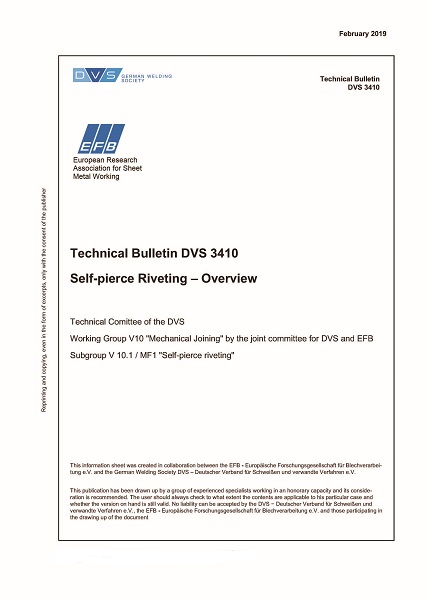Self-pierce Riveting – Overview
Medien-Nr.:
MB-3410_e
Produktnummer:
MB_3410_e_0
Herausgeber:
Europäische Forschungsgesellschaft Blechverarbeitung e.V. und DVS – Deutscher Verband für Schweißen und verwandte Verfahren e.V. - Gemeinschaftsausschuss "Mechanisches Fügen"
Erscheinungsjahr:
1. Januar 2020
This guideline provides users of the joining process "self-pierce riveting with semi-tubular and solid self-pierce rivet" with an overview and information on the technology, the design of components, suitable materials and their quality assurance.
In self-pierce riveting, overlapping parts are joined without pre-piercing using solid or semi-tubular self-pierce rivets (hereinafter also referred to as joining elements). The mechanism of action is based on a combination of force and form locking.
In self-pierce riveting with half-hollow pierce rivet, the joining element is pressed through the punch-side joining part (the punch-side joining parts in the case of multilayer joints) in an uninterrupted joining process and the die-side joining part is formed with the aid of the rivet and die geometry.
Inhalt
1. Purpose and scope of the guideline
2. Fundamental principles
2.1. General
2.2. Definitions
2.2.1. Self-pierce riveting with semi-tubular self-piercing rivets
2.2.2. Self-pierce riveting with solid self-piercing rivets
2.3. Joining properties
2.3.1. Mechanical properties
2.3.2. Chemical and thermal stresses
2.3.3. Other forms of load
3. Design
3.1. Symbolic representation on drawings
3.2. Constructive component design
3.2.1. Scope of application for semi-tubular self-pierce riveting
3.2.2. Scope of application for solid self-pierce riveting
4. Production
4.1. Machinery and equipment
4.1.1. Tools
4.1.2. C-frame
4.1.3. Feeding unit
4.1.4. Drive
4.1.5. Control system
4.1.6. Accessories
4.2. Parameters and process information
4.3. Process monitoring
5. Quality assurance
6. Reworking and repairs
7. Occupational safety and environmental protection
7.1. Occupational safety
7.2. Environmental protection
8. Special processes
8.1. Self-pierce riveting with a flat anvil
8.2. Flange self-pierce riveting
8.3. Self-pierce riveting with overlaid motion
8.4. Impulse self-pierce riveting with single impulse
8.5. Impulse self-pierce riveting with multiple impulse
8.6. Self-pierce riveting with component heating
8.7. Hydro self-pierce riveting
9. References
In self-pierce riveting with half-hollow pierce rivet, the joining element is pressed through the punch-side joining part (the punch-side joining parts in the case of multilayer joints) in an uninterrupted joining process and the die-side joining part is formed with the aid of the rivet and die geometry.
Inhalt
1. Purpose and scope of the guideline
2. Fundamental principles
2.1. General
2.2. Definitions
2.2.1. Self-pierce riveting with semi-tubular self-piercing rivets
2.2.2. Self-pierce riveting with solid self-piercing rivets
2.3. Joining properties
2.3.1. Mechanical properties
2.3.2. Chemical and thermal stresses
2.3.3. Other forms of load
3. Design
3.1. Symbolic representation on drawings
3.2. Constructive component design
3.2.1. Scope of application for semi-tubular self-pierce riveting
3.2.2. Scope of application for solid self-pierce riveting
4. Production
4.1. Machinery and equipment
4.1.1. Tools
4.1.2. C-frame
4.1.3. Feeding unit
4.1.4. Drive
4.1.5. Control system
4.1.6. Accessories
4.2. Parameters and process information
4.3. Process monitoring
5. Quality assurance
6. Reworking and repairs
7. Occupational safety and environmental protection
7.1. Occupational safety
7.2. Environmental protection
8. Special processes
8.1. Self-pierce riveting with a flat anvil
8.2. Flange self-pierce riveting
8.3. Self-pierce riveting with overlaid motion
8.4. Impulse self-pierce riveting with single impulse
8.5. Impulse self-pierce riveting with multiple impulse
8.6. Self-pierce riveting with component heating
8.7. Hydro self-pierce riveting
9. References

